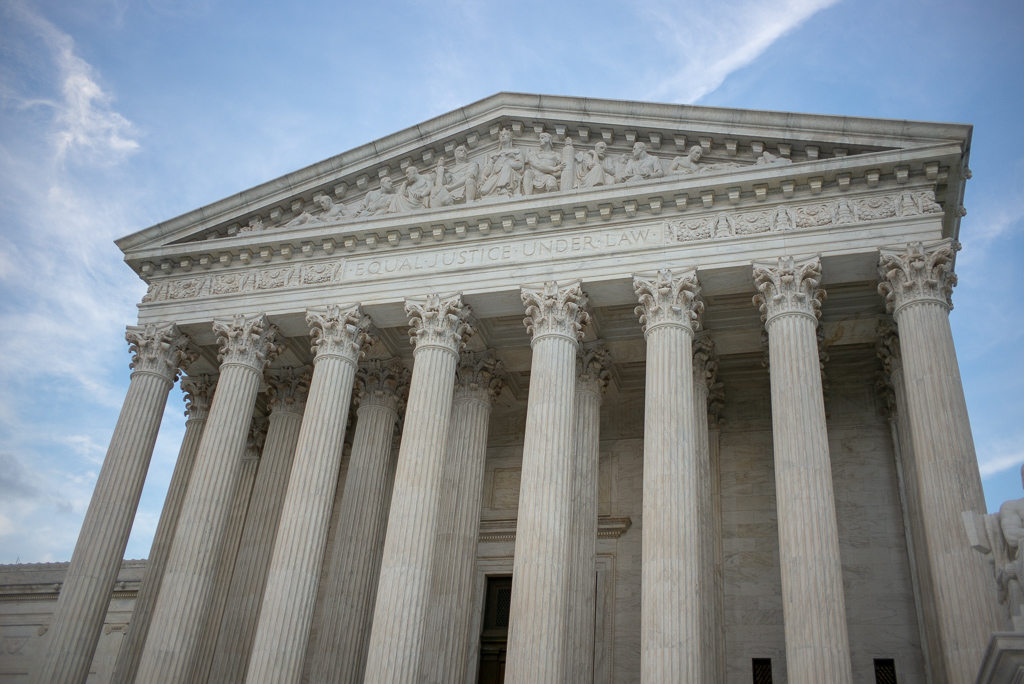Four Months Later, How Are Courts Interpreting Carpenter?
Last June in a 5-4 ruling in Carpenter v. United States, the Supreme Court extended Fourth Amendment protections to an individual’s cell phone location data for the first time.

Published by The Lawfare Institute
in Cooperation With

Last June in a 5-4 ruling in Carpenter v. United States, the Supreme Court extended Fourth Amendment protections to an individual’s cell phone location data for the first time. Many commentators described Carpenter as a “landmark” decision, but just how far the decision’s reasoning will extend is still an open question. As Orin Kerr put the uncertainty: “[Y]ou now have a right not to be monitored too much without a warrant.” And as Paul Rosenzweig put it in the days after the decision:
Anyone who says they can read the majority opinion and predict with any degree of confidence how the Court will deal with any number of future technologies—be they biometrics, facial recognition, DNA or real-time cell-site location information (CSLI)—is, frankly, just making it up.
With lower courts having had to grapple with Carpenter for four months now, observers now have the first answers of how the ruling will be interpreted. So far, the decision’s impact has been muted. In general, two themes emerge from the published decisions. First, the good-faith exception has barred defendants in pending criminal appeals from suppressing cell-site location information, or CSLI, evidence obtained in searches that pre-date Carpenter; every federal court to consider such a motion has ruled for the government. Second, courts have been reluctant to extend Carpenter to searches beyond CSLI. In criminal appeals, no federal court has extended Carpenter to a significant set of new facts. However, one state court decision and one civil case in federal court offer a sense of how Carpenter may be stretched to other types of data collected by the government.
Carpenter’s Holding
Carpenter reached the Supreme Court after the government used historical CSLI obtained without a warrant as evidence placing a defendant at the scene of a robbery. In a 5-4 decision, the court held that the government must obtain a warrant to acquire seven days of CSLI from a cellular provider. Writing for the court, Chief Justice John Roberts found that the Fourth Amendment extends to CSLI on the grounds that an individual holds a “reasonable expectation of privacy in the whole of his physical movements.” Since people take their phones just about everywhere they go, the majority reasoned, CSLI reveals deeply personal information: “A cell phone faithfully follows its owner beyond public thoroughfares and into private residences, doctor’s offices, political headquarters, and other potentially revealing locales.”
In addition, even though the government had obtained the data from a third-party provider, the court rejected the application of its third-party doctrine precedents, under which individuals who had knowingly revealed information to third parties were found to have forfeited Fourth Amendment protections. Crucial to the court’s reasoning was its evaluation of the particularly revealing nature of CSLI. The court also emphasized that “phone location information is not truly ‘shared’ as one normally understands the term.”
Finally, the court cabined its holding by calling the decision “a narrow one” and stating: “We do not express a view on matters not before us: real-time CSLI or “tower dumps” (a download of information on all the devices that connected to a particular cell site during a particular interval). We do not disturb the application of Smith and Miller or call into question conventional surveillance techniques and tools, such as security cameras. Nor do we address other business records that might incidentally reveal location information.”
The Good-Faith Exception
Before Carpenter was decided, Orin Kerr noted that the defendant in the case would not gain any relief even if he won at the Supreme Court due to the good-faith exception, under which evidence cannot be suppressed at trial when law enforcement relies on a defective court order in good faith. That observation has proven true for almost all defendants in pending criminal appeals involving CSLI obtained pre-Carpenter. The Second Circuit, Fourth Circuit, Seventh Circuit, and Eleventh Circuit, well as numerous federal district courts and state courts—have all relied on the good-faith exception to deny defendants’ motions to suppress evidence.
Under the exclusionary rule, illegally obtained evidence is inadmissible in court. The exclusionary rule is intended to deter misconduct by law-enforcement investigators. But according to the good-faith exception, when the government relies either on a statute that is not “clearly unconstitutional” or on “binding precedent,” suppression of evidence is not an appropriate remedy since the deterrence effect is diminished. For defendants challenging the use of CSLI evidence in pending criminal appeals after Carpenter, the exception leaves few options for two reasons: First, in nearly all cases, the government acted in compliance with the Stored Communication Act to obtain the evidence. Second, Carpenter made it to the Supreme Court without a circuit split, meaning that defendants cannot cite any appellate precedent that stood in their favor during the relevant period.
Defendants have nonetheless attempted to argue that the government’s obtaining CSLI data without a warrant was constitutionally unsound pre-Carpenter. Before a federal court in Connecticut, one defendant convicted of violent crimes argued:
[A] reasonable officer should have seen the writing on the wall after the Supreme Court's decisions in Kyllo v. United States (holding that the use of a thermal imager to detect heat radiating from home was a search), United States v. Jones (holding that installation of a GPS device on a target's vehicle constituted a search), and Riley v. California (holding that police must generally obtain a warrant before searching the contents of a phone).
But judges have uniformly rejected this argument on the ground that even the Carpenter court noted that the issue at bar did not “fit neatly under existing precedents.” Moreover, judges have also pointed to the fact that, as the Supreme Court predicted in a 1987 case dealing with the good-faith exception, the doctrine has not overly disincentivized litigation seeking to vindicate constitutional rights: Defendants like Carpenter have taken Fourth Amendment claims to the Supreme Court despite being extremely unlikely to benefit from any potential relief.
Using reasoning of this sort, a smattering of federal and state courts have invoked the good-faith exception to deny defendants’ motions to suppress evidence. Most state courts have done the same, with a few exceptions. A Florida state appellate court ordered a new trial, in part, on the grounds that the exclusionary rule applied to CSLI evidence. That court held that since the “case law concerning historical CSLI was unsettled” in 2001 (when the government obtained the CSLI) and investigators relied on a pen-register statute that did not address CSLI, the good-faith exception did not apply. In Delaware, a trial court applying Carpenter suppressed two-years of a defendant’s CSLI, also obtained pre-Carpenter, that was challenged on state constitutional and Fourth Amendment grounds. According to the Delaware Supreme Court, there is no good-faith exception under that state’s constitution.
Hesitation to Extend Carpenter
Despite the chief justice’s admonition about the narrowness of Carpenter’s holding, defendants have tried to extend Carpenter beyond CSLI data. In denying a defendant’s attempt to suppress an IP address obtained from an internet-service provider, the Fifth Circuit wrote that Carpenter is restricted to data revealing a “person’s day-to-day movement.” Similarly, federal courts have disposed of efforts to apply the new precedent to law enforcement’s use pole cameras—hidden video cameras, sometimes mounted on utility poles, that conduct 24/7 surveillance on a suspect. In one Wisconsin case, investigators used evidence obtained from a pole camera to obtain a search warrant of a defendant’s home, where they found distribution-quantities of opioids. In claiming that the warrantless use of the pole camera violated his Fourth Amendment rights, the defendant attempted to construe Carpenter as admonishing excessive police surveillance. The court rejected that argument, emphasizing that “Carpenter was a limited decision” and that “unlike the new technology addressed in Carpenter ‘the surveillance here used ordinary video cameras that have been around for decades.’” Another federal court in Wisconsin rejected a defendant’s argument challenging investigator’s use of evidence obtained by a pole camera on the grounds that Carpenter had endorsed the “mosaic theory” of the Fourth Amendment, limiting the government from surveillance activities over a long period of time.
A federal district court in Tennessee upheld the government’s access of CSLI data of a phone for which the defendant denied “ownership, possession, control, use, and exclusion of others.” The court rejected a defendant’s argument that Carpenter created a broad privacy interest in an individual’s physical movements that the decision aberrated general principles of Fourth Amendment standing. That court concluded: “In the Court's view, Carpenter has not changed that, before Defendant can assert a Fourth Amendment violation, he has to be able to assert a personal connection to the place or object in which he claims a privacy right.”
Many courts have directly relied in multiple cases on the chief justice’s admonition about the narrowness of the court’s holding in declining to extend Carpenter to real-time GPS location, utility records, and information from a cell service provider related to an IP address and cell phone number. In the GPS location case, the Florida Supreme Court rejected the extension of Carpenter to “real-time cell-site location information to locate [the defendant] for the purposes of executing the warrant,” citing the Carpenter Court’s statement that: “We do not express a view on matters not before us: real-time CSLI.”
Still, one Florida appellate court has extended Carpenter’s warrant requirement to a cell-site simulator, a device that mimics a cell tower to tricks cellphone into connecting to it, reasoning that: “If a warrant is required for the government to obtain historical cell-site information voluntarily maintained and in the possession of a third party ... we can discern no reason why a warrant would not be required for the more invasive use of a cell-site simulator.”
Another indicator of where Carpenter may be headed comes from the Seventh Circuit. (Read Orin Kerr’s analysis of it.) A group of citizens brought a Fourth Amendment challenge against a city that installed smart electricity meters in every home. The citizens alleged that recording and saving their electricity consumption at 15-minute intervals constituted a Fourth Amendment search. Relying on Carpenter, the court found that the electricity data at issue was analogous to CSLI in that neither were shared voluntarily. The court ultimately held that the city’s collection of the electricity data constituted a search but ruled for the city on the grounds that the search was reasonable.
***
It’s still too early to determine Carpenter’s fate. Its impact has so far been limited. The good-faith exception has washed out cases involving pre-Carpenter searches. Courts seem to have cold feet about extending the logic of Carpenter, but as new fact patterns arise, that may change.


-final.png?sfvrsn=b70826ae_3)

